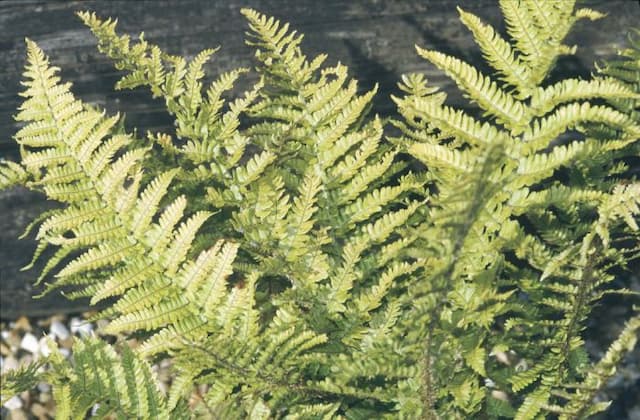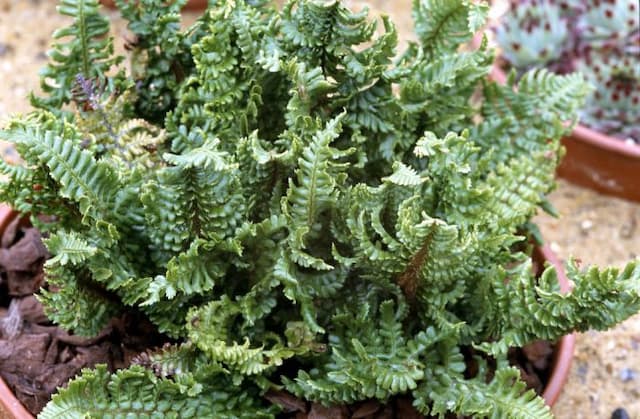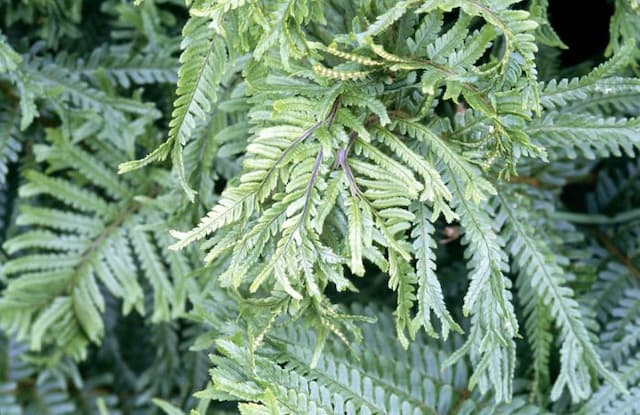Clinton's Wood Fern Dryopteris clintoniana

ABOUT
The Clinton's Wood Fern, commonly known as Dryopteris clintoniana, is a perennial fern with a robust and arching appearance. Its fronds are pinnately compound, meaning each frond is divided into smaller leaflets, which are further divided into subleaflets, giving a lacy and textured look to the foliage. The color of the fronds is a rich, deep green, providing a lush and dense visual in shaded garden areas or forest understories. The stems (stipes) often have a contrasting coloration, with scales that range from light brown to a more orange-brown hue. The overall shape of the fern is somewhat vase-like, with the fronds arranged in a circular pattern emerging from a central point, creating a symmetrical and orderly appearance. At the base, the fronds are broader, tapering towards the tip which is often pointed. Each subleaflet has a toothed or serrated margin that adds to the detailed texture of the plant. Lastly, on the underside of the leaflets, reproductive structures called sori can be found, usually arranged in a line along the central vein, but these are not always visible without turning a frond over.
About this plant
 Names
NamesSynonyms
Clinton's Wood Fern, Clinton's Fern
Common names
Aspidium clintonianum, Dryopteris cristata var. clintoniana, Dryopteris goldiana var. clintoniana.
 Toxicity
ToxicityTo humans
Clinton's wood fern is not commonly known to be toxic to humans. There are no significant reports of toxicity or symptoms associated with the ingestion of this fern by humans. However, as with many plants, it is generally advisable to avoid eating parts of plants that are not known to be edible.
To pets
Clinton's wood fern is not commonly known to be toxic to pets. This plant does not contain known toxins that are harmful to dogs, cats, or other domestic animals. Therefore, ingestion of this fern by pets is unlikely to cause poisoning or produce symptoms of concern. However, caution should still be exercised since individual animals may have different sensitivities, and it is generally best to prevent pets from eating ornamental plants.
 Characteristics
CharacteristicsLife cycle
Perennials
Foliage type
Deciduous
Color of leaves
Green
Height
2-3 feet (60-90 cm)
Spread
1-2 feet (30-60 cm)
Plant type
Fern
Hardiness zones
3-7
Native area
North America
Benefits
 General Benefits
General Benefits- Ecosystem support – Dryopteris clintoniana, commonly known as Clinton's Wood Fern, provides habitat and food for various insects and wildlife.
- Erosion control – Thanks to its rooting system, the plant helps stabilize soil and prevent erosion in the areas it grows.
- Aesthetic appeal – With its lush, green fronds, Clinton's Wood Fern is often used in shade gardens and natural landscaping for visual interest.
- Diversity in landscaping – It adds variety to plant selections in gardens, particularly in shaded or woodland areas.
- Low Maintenance – Clinton's Wood Fern requires minimal care once established, making it suitable for naturalistic plantings and less intensive gardening.
- Tolerance of shade – This fern thrives in low-light conditions where other plants may struggle, making it ideal for shady gardens.
- Seasonal interest – It can provide greenery throughout the growing season and often changes color with the seasons, adding to its ornamental value.
 Medical Properties
Medical Properties- This plant is not used for medical purposes.
 Air-purifying Qualities
Air-purifying QualitiesThis plant is not specifically known for air purifying qualities.
 Other Uses
Other Uses- Horticultural Accents: Clinton's wood fern can be used in gardens as a shade-loving groundcover or a textural contrast to other garden plants.
- Erosion Control: The dense root system can help stabilize soil in shady areas where erosion might be a concern.
- Decorative Crafts: The fronds of Clinton's wood fern can be pressed and used in botanical prints or other decorative crafts for a natural aesthetic.
- Biomonitoring: This plant could potentially be used as a biomonitor as ferns are known to accumulate metals, indicating environmental conditions.
- Education: Clinton's wood fern is an ideal plant for teaching about fern reproduction and lifecycle, due to its size and the visibility of its spores.
- Culinary Garnish: Though not commonly consumed, the young fiddleheads could be used as an ornamental garnish for plating in gourmet cooking.
- Wildlife Habitat: The dense foliage provides shelter and nesting material for small woodland creatures and insects.
- Photography Subjects: The intricate fronds and green hue of Clinton's wood fern make it a beautiful subject for nature and macro photography.
- Companion Planting: Clinton's wood fern can be planted alongside other shade-loving plants to create a lush, layered garden effect.
- Carbon Sequestration: Like many plants, ferns absorb CO2 and can play a role in sequestering carbon in garden settings.
Interesting Facts
 Feng Shui
Feng ShuiThe Clinton's woodfern is not used in Feng Shui practice.
 Zodiac Sign Compitability
Zodiac Sign CompitabilityThe Clinton's woodfern is not used in astrology practice.
 Plant Symbolism
Plant Symbolism- Endurance: As a fern, Clinton's Wood Fern illustrates the ability to thrive in challenging environments, symbolizing one's capacity to endure and persist through difficult times.
- Protection: Ferns often symbolize shelter and protection, as in the wild they can provide cover for smaller plants and creatures, reflecting the idea of safeguarding and defending oneself or others.
- Eternal youth: Being a plant that can rejuvenate from its fronds, Clinton's Wood Fern embodies the concept of renewal and the perpetual aspect of nature's life cycle.
- Solitude: As it can often be found growing alone in the forest, it can represent a love for solitude and the beauty of a peaceful, solitary life.
 Water
WaterClinton's Wood Fern should be watered thoroughly, ensuring that the soil is moist but not waterlogged. Aim to water the plant every week with approximately one to two gallons of water, depending on the size of the plant and the environmental conditions. During the active growing season in spring and summer, water regularly to maintain consistent soil moisture. In the fall and winter, reduce the frequency to when the top inch of soil feels dry to the touch. Make sure the pot has good drainage to prevent root rot.
 Light
LightClinton's Wood Fern thrives in partial to full shade. It is best situated in a spot that receives filtered light or is shaded for part of the day, mimicking its natural woodland habitat. Direct sunlight should be avoided as it can scorch the fronds and cause the plant to dry out. The ideal location is under a canopy of trees or in a shaded north-facing garden.
 Temperature
TemperatureClinton's Wood Fern prefers temperatures between 60 to 70 degrees Fahrenheit. It can tolerate a minimum temperature of about 50 degrees Fahrenheit and a maximum of about 80 degrees Fahrenheit, but extreme temperatures should be avoided. This fern will grow optimally in a cool, stable environment typical of its native forest understory.
 Pruning
PruningPrune Clinton's Wood Fern by removing any dead or damaged fronds to maintain a healthy appearance and encourage new growth. Pruning is best done in the spring before new fronds unfurl. Typically, this type of fern requires minimal pruning, and periodic trimming will suffice. It is not necessary to prune the plant regularly – only as needed to tidy up the plant.
 Cleaning
CleaningAs needed
 Soil
SoilClinton fern thrives in well-draining, moist soil that is rich in organic matter. A mix of loam, peat, and sand is suitable to facilitate drainage while maintaining moisture. The ideal soil pH for Clinton fern should be slightly acidic to neutral, ranging from 5.0 to 7.0.
 Repotting
RepottingClinton ferns do not require frequent repotting; they should generally be repotted every 2-3 years. This timing can depend on the growth rate and size of the plant. When the fern outgrows its pot or the soil is exhausted, it’s time to repot.
 Humidity & Misting
Humidity & MistingClinton ferns prefer high humidity levels, typically between 60% to 80%. To maintain these conditions, the plants can benefit from regular misting or being placed in a naturally humid environment, such as a bathroom.
 Suitable locations
Suitable locationsIndoor
Ensure high humidity, indirect light, and moist soil.
Outdoor
Part shade, consistently moist soil, protect from harsh elements.
Hardiness zone
3-8 USDA
 Life cycle
Life cycleClinton's Wood Fern (Dryopteris clintoniana) begins its life cycle as a spore, which germinates to produce a small, heart-shaped gametophyte (prothallus). The gametophyte houses both male and female reproductive organs and, upon maturation, the sperm swims to the egg to facilitate fertilization. The fertilized egg then develops into a young fern (sporophyte), transitioning through a juvenile phase characterized by smaller, simpler fronds. As the plant matures, it produces larger, more complex fronds and becomes capable of sexual reproduction. The mature sporophyte generates spores in sori located on the underside of the fronds, completing the life cycle when these spores are dispersed to begin a new generation. Clinton's Wood Fern's life cycle exemplifies the alternation of generations, with distinct haploid gametophytic and diploid sporophytic phases.
 Propogation
PropogationPropogation time
Spring-Early Summer
Dryopteris clintoniana, commonly known as Clinton's wood fern, can be propagated through division, which is the most popular propagation method for this fern. The optimal time to propagate is in the early spring as the new fronds, or fiddleheads, are starting to unfurl. To propagate by division, carefully dig up the plant, making sure to keep a good amount of the root system intact with each section. The root clump can then be gently pulled apart into smaller clumps, ensuring that each has at least one developing fiddlehead and a portion of the root system. These divisions can then be planted in a moist, well-drained soil, ideally in a shaded or semi-shaded location, and watered thoroughly to help establish the new plants. Each division should be spaced approximately 18 inches (ca. 45 cm) apart to allow for growth and air circulation.









